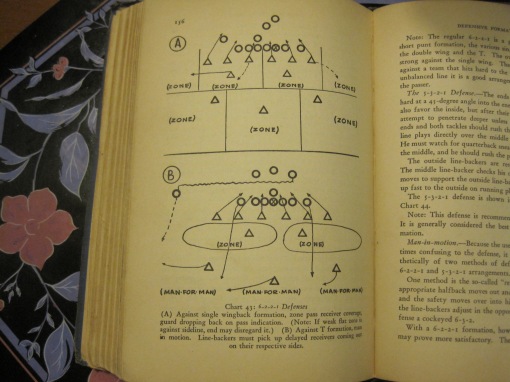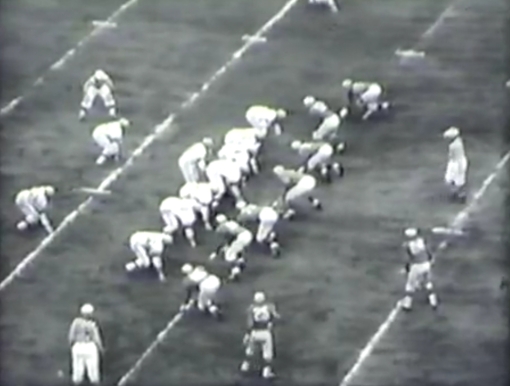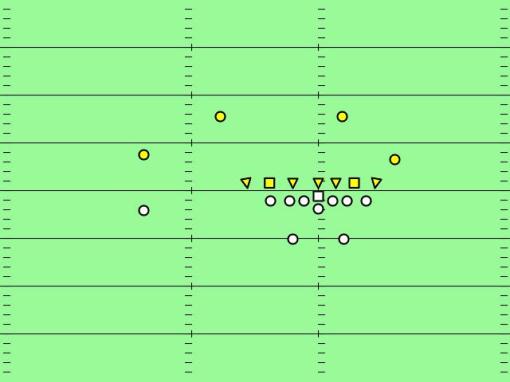In 1947, defensive theory in football had not yet advanced to the level of offensive theory. I’m saying this because the focus of defensive line play was gladitorial in nature: you would beat the man in front of you, pursue the ball carrier and tackle, preferably with the best form possible. Adjustments were rare. People had to accommodate man in motion but that was about it. The notion of a defensive key isn’t even talked about (1).
In the late 1940s to mid 1950s, defensive linemen were somewhat interchangable, and there were no specific guidelines for the sizes of defensive tackles, defensive ends, or middle guards. The roles of these linemen weren’t as detailed and specific as they are in modern days. There were big powerful immobile linemen, and smaller, faster, more nimble linemen. And though people like to think of linemen falling back into zones as a modern invention, the tactic was used in Steve Owen’s 6-1 Umbrella, and sees time in the pages of Dana Bible’s book:
The idea, therefore, of a middle guard falling back into coverage wouldn’t have caused anyone in 1947 to blink an eye. So when you have a middle guard with sprinter’s speed, a guy like Bill Willis,

Cleveland Browns all pro middle guard Bill Willis (1946-1952). As big as the centers of his time with sprinter’s speed (2).
the idea that he should be a part of coverage would have been expected. Good linemen would fall back from the line and into coverage when the situation demanded. Linemen rushed yes, but behaved more like modern linebackers when they had to.
“He often played as a middle or noseguard on our five-man defensive line, but we began dropping him off the line of scrimmage a yard because his great speed and pursuit carried him to the point of attack before anyone would block him” (3)
So why is this important? It’s important because the dominant defensive front from 1950 or so through 1955 is a five man front, often a 5-2 Eagle. An example comes from this screen shot of video of the 1953 NFL championship
when diagrammed, would look something like this:
And therefore, the appearance of 4-3 fronts, as a product of a middle guard digging into the “bag of tricks” a lineman was supposed to know, should have been expected. 4-3s would have appeared as a poor man’s prevent defense, or as a response to specific game events, like quarterbacks throwing the ball just over the head of Chicago’s middle guard, Bill George.
…in a game against the Philadelphia Eagles, George made a now historic move that permanently changed defensive strategy in the National Football League.
On passing plays, George’s job was to bump the center and then drop back. George, noting the Eagles success at completing short passes just over his head, decided to skip the center bump and drop back immediately. Two plays later he caught the first of his 18 pro interceptions. While no one can swear which middle guard in a five-man line first dropped back to play middle linebacker and create the classic 4-3 defense, George is the most popular choice.
This game dates to 1954. Andy Piascik’s book claims that in the regular season game between the Detroit Lions and Cleveland Browns in 1952, the Lions employed a 4-3 (4). I’d suggest though, in the absence of any evidence to the contrary, that these 4-3s fall into the form of an adjustment to the 5-2, as opposed to an integral coordinated defensive system.
The deal is, by 1956, Tom Landry, as the defensive coordinator of the New York Giants, has a 4-3 that isn’t anyone’s adjustment to something else. It’s a full blown base defense, a creation of his own hard work and imagination. It’s a largely 1 gap, keying defense, with distinct assignments to the linemen. Linemen have to fill gaps and keep the offensive line from getting to the middle linebacker. The middle linebacker roams, tackles, covers his two gaps. The initial Landry defenses have been lavishly detailed in the two volume text “Vince Lombardi on Football“, because these were the defenses Vince took with him to Green Bay.
And while what video I can watch in the period from 1948 to 1955 has yet to yield a single 4-3, the Giants live in it in the 1956 Championship game, and after some initial five man line in the 1957 Championship game, Detroit soon switches to a 4-3 and stays in it.
All this lends credence to the words of Paul Zimmerman (5)
Here and there the 4-3 popped up around the league. The Eagles got into a form of it when they had their middle guard, Bucko Kilroy, stand up, though at 258 pounds he hardly had true middle-linebacker responsibilities. The Redskins tried it, lifting middle guard Ron Marcinak and substituting a linebacker, Charley Drazenovich.
Landry graduated from player to player-coach to defensive coach under Jim Lee Howell. Vince Lombardi ran the offense. In 1956 the Giants drafted a tackle from West Virginia, Robert Lee Huff, nicknamed Sam, who had been born to play middle linebacker in the 4-3, and that became the Giant’s official standard defense. By 1957 everyone was in it.
So the real question is, how much of this 4-3 defensive system was prior art? Not the positions, mind you, but the components. The keys, the coordination, the pieces? I think the minimum you need to make such a defense are these three elements.
1. Film study. Without it you can’t really predict trends.
2. Two platoon football. Otherwise, you’re teaching one player offense 80% of the time.
3. A modern coaching staff, with full time assistants.
It’s very clear that Paul Brown’s staff with the Cleveland Browns has these three elements in the 1950s, but I don’t see signs that they were unusually innovative on defense. Instead, what you see are things like references to three man single safety backfields (6), and signs that they were working within the status quo of the times.
One resource I’d love to get my hands on is the writings of the former Cleveland Browns linebacker, Hal Herring (7). He played for the Browns for three years, starting in 1950. Later, he wrote a dissertation that was titled “Defensive Tactics and Techniques in Professional Football.” I’m not close enough to a research library to know if it can easily be obtained, but back in the day when I was writing my own dissertation, we had to make dissertations available to just about anyone who wanted a copy.
Update: correction on the Bill George date.
~~~
Notes and References
(1) Keys and tells are different beasts. A tell is Dan Fouts giving away run or pass in 1979 with his feet placement. An example of a key is a person whose actions tell you where to go and what role to play when you do. Tells have been part of football forever, akin to stealing signs. Keys are elements of the game that have to be built into the defense and coached.
(2) Image from Special Collections, Cleveland State University Library.
(3) Paul Brown, quoted by Goldstein.
(4) Piascik, Chapter 11. The exact quote is:
“I think the 4-3 defense originated with him [Parker] and his coaches,” Dub Jones said of the Detroit team that so stifled Cleveland in that first ever meeting between the two teams. “They threw that in our face in ’52 and it was tough for us to cope with, having not faced it.”
(5) Zimmerman, Chapter 6.
(6) Brown and Clary, p 220, has this interesting blurb regarding the 1951 NFL championship:
For several years, our secondary had never declared a strong side of our opponent’s offensive formation until it saw which direction the fullback was going, and though we had gotten by with this strategy, it put a great burden on Cliff Lewis, the middle safety in our three-man secondary.
(7) Piascik, Chapter 8.
Bibliography
Bible, Dana X, “Championship Football”, Prentice-Hall, New York, 1947.
Brown, Paul and Clary, Andy, PB: The Paul Brown Story, Atheneum, New York, 1979.
Goldstein, Richard, “Bill Willis, 86, Racial Pioneer in Pro Football, Dies”, New York Times, Nov. 29, 2007, accessed Jun 7, 2013.
Piascik, Andy, The Best Show in Football: The 1946-1955 Cleveland Browns – Pro Football’s Greatest Dynasty [ebook]
Zimmerman, Paul, New Thinking Man’s Guide to Professional Football, Harper Collins, 1984.



June 8, 2013 at 4:44 pm
Going through Zimmerman’s 1984 book right now. It’s good to see someone attempt to pull together all these football resources and nail down the creation of the 4-3 defense (from a professional perspective). I’ve seen so many different accounts of the “first” 4-3 defense, but nobody even sits down and defines the term (which you do), something I hadn’t even known was important despite all these problems dogging the historical record.
So as a systematized defense, with coordination, fundamental philosophies, etc. your first intuition seems to be that Landry invented it?
From Jene Bramel’s excellent article, it seems like the flex was originally an adaptation of the 6-1 umbrella that gave its defensive linemen an advantage against option blocking (something I think MacCambridge reinforced in his fantastic historical account). Does that mean the 4-3 defense proper was an evolution of the 6-1 flex that Landry eventually systematized? In that sense, then, did he end up looking for different personnel to fit the 4-3 defense over the 6-1 umbrella flex?
Looking forward to your response.
June 8, 2013 at 5:39 pm
I’m not familiar with a “6-1 Umbrella Flex”, but if what you’re getting at is the defense Steve Owen is accredited with and Landry did most of the grunt work for, then most any historian would consider it the predecessor to the modern 4-3. Steve Owen’s 6-1 was intended to slow down the passing attack of the Cleveland Browns, who had the “West Coast Offense” of their day: the best passing attack, the best QB, the best balance, and superb blocking along the offensive line. There is excellent coverage of all this in Dr Z’s 6th chapter, as well as Paul Brown’s book.
Landry invented a gap control 4-3 relying heavily on keys learned through intensive film study. It was the first 4-3 used as a team’s base defense. It was a fine defense, and it won the 1956 NFL championship for the New York Giants. I’d say it’s clearly a modern defense, with specific roles a bit more defined than ‘git the man wit the ball’. Landry’s defenses will fall apart if the defense doesn’t act as a coordinated whole.
This isn’t proof that it’s the first modern defense. That defense may have been invented in the college ranks – there are, after all, many more colleges than NFL teams – and may be, for example, the 5-4 that Bud Wilkinson used at Oklahoma.
But for me, Tom’s 4-3 is the first recognizably complex and modern defense, much as the T formations of 1940 were the first recognizably modern offenses.
Understand, even in the modern era, if you have markedly superior players, a “beat the guy in front of you and git to the ball’ is still all you need. The 46, after all, is an offbeat 6-2-3, about as old a defense as exists in the NFL (well, the 7 diamond does predate it, but not by much).
Landry’s first 4-3 wasn’t the flex. The flex is a later development, and the flex as perhaps used with the New York Giants may not be the flex that Landry honed to the talents of Bob Lilly. That’s something I’m still researching. Sam Huff’s description of flex shifts in Dr Z’s book are entirely the opposite of the shifts Bob Lilly describes in Pete Golenbock’s book on the Cowboys.
So I read and hope to learn more. This article is a work in progress, and I may be publishing more on the topic, as I learn more.
June 8, 2013 at 6:06 pm
Thanks for the response. I may have erroneously thrown in the word flex for the 6-1 umbrella, but that is in fact what I was getting at.
I did not know that Landry’s first 4-3 wasn’t a variation on the flex. Keep me updated, I’ll be reading along.
June 12, 2013 at 9:35 am
[…] The thing to note is the role of the two linebackers. So, in comparison to Eagle defenses today, very often you’re going to find linebackers in Earle Neale’s defense playing a 6 or 7 technique, instead of a 50 (See the image in my previous 1950s article). […]
December 19, 2014 at 11:33 pm
I’d be interested to know how defenses confronted with the T-formation responded to motion out of the backfield to a flanker position. I’m really interested in when and how the transition was made in the pro game to the split end/flanker set with just two backs in the offensive backfield, and what kind of pass route concepts Paul Brown’s offenses were using to stress the 5-3 and 6-2 defenses that preceded the 4-3. I’m just guessing a tight end would run take a quick inside release and get open behind the middle guard of a 5-2. Apparently the Browns would also throw passes to the flats if it’s notable that Steve Owen’s New York team dropped their DE’s into flat coverage against them. Really interesting how this stage of the development of the game played out.
December 20, 2014 at 11:55 am
* I’d be interested to know how defenses confronted with the T-formation responded to motion out of the backfield to a flanker position
Then you will have to go back to the Chicago Bears teams of Ralph Jones, because he was the one who first modernized the T, increasing the gaps between linemen and introducing newfangled concepts like man in motion. This suggests that man in motion was already in use at innovative colleges and he just passed the practice into the pros.
http://en.wikipedia.org/wiki/Ralph_Jones
I will warn you that some of the commentary in the Wikipedia article doesn’t pass the “smell test”.
From Steve Owen’s Book, “My Kind of Football”, his reaction to the early 1930s Bears was to invent the 5-3 defense. The 6-2 of the 1930s and the 5-3 were reactions in general to the more high powered offenses of the times. The 7-1-2-1 (7-diamond) and 7-2 were then considered obsolete defenses.
In the middle 1940s, the “flanker offense” appeared. Images of it should be in one of my 5-2 defense articles. It was not a man in motion, but a flanker stationed outside the offensive ends.
The image here shows a early 1950s “flanker offense”.
http://en.wikipedia.org/wiki/5%E2%80%932_defense#5-2_Eagle.
Tight and split ends didn’t exist in the early/mid 1940s. There were just offensive ends. That kind of specialization only came about late 1950s or so. Splitting an end, if I recall right, was something Clark Shaughnessy first did with the Cleveland/LA Rams, when he was head coach, in the late 1940s. Reading Paul Brown talk about Len Ford is very instructive in how folks treated ends back in the 1940s early 1950s.
Very wide end splits did not happen in college until the “lonely end” days, the last years of Paul Blaik. And they did cause defensive disruption.
The kind of receivers that caused the most trouble for the 5-2 were not ends, but slotted receivers in roughly the tight end position, off the line, where the outside linebackers of the 5-2 could not bump them. In those times, they would have been called wingbacks.
December 20, 2014 at 6:22 pm
Thanks for your reply. I read the Ralph Jones wikipedia page. That was the first reference I’ve ever had to him and his accomplishments, so I appreciate your insight into the subject. Wikipedia’s page on the T-Formation mentions a distinct version of the T called the “Split T” with larger line splits than the foot to foot splits that were common at the time, but they don’t mention Ralph Jones in that particular reference. I’ve read some articles that talk about a “wedge” or “plunge” play where it sounds like the offense attempted to generate forward yardage by getting a push without opening a gap or hole as in modern schemes that utilize wider splits and facilitate openings for a back to run through. These are usually teams pre-1933 when the single wing was still in common use, and the forward passing game was still operating under some rules restrictions that made passing more prohibitive strategically. It stands to reason that early defenses would have likely attempted to mirror offensive alignments and play what we would call a 2-gap technique in modern terminology, then just pursue to the ball. The best reference I could find states that the rule requiring 7 offensive players on the LOS was made in 1910. The forward pass was legalized in 1906, and was already in use at that time. So before a more developed strategy was invented through necessity, the defense would likely counter 7 offensive players on the line with 7 defenders pushing back, and mirror the 4 offensive backs with 4 defensive backs/linebackers to flow to the ball. Seems like 5-3 and the 6-2 defensive fronts would have been a natural occurrence to counter short dump passes behind the defensive line. That’s not based off of any specific research I’ve done, not for lack of trying to find references, just me trying to reason it out. Your website really is one of the best references I’ve found on this subject, and I can certainly tell you that you’re much more well-read on the subject than I am. I’m trying to connect those early phases of development of offense/defense to the modern game through the changes that were implemented over the years by the games greatest innovators. You’ve got a great site here, I intend to keep reading particularly your historical-evolution of the game related materials.